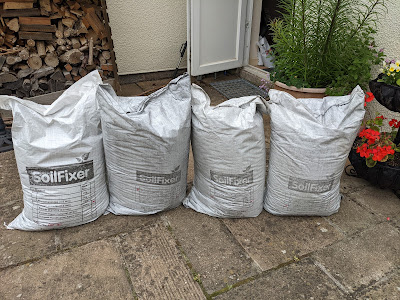In my earlier post, I listed the equipment used for hot composting. Perhaps not unexpectedly there were a few things I forgot or missed. So I've got 4 more items to add with no guarantee that there won't be more.
1. Biochar
 |
| Biochar Delivery from SoilFixer |
Not strictly speaking equipment but an important additive to use during composting. I have already posted about the advantages of adding biochar to your soil. You can add biochar directly to your soil either in a newly dug plant hole or as a general soil dressing. The preferred method, however, is to add biochar to your compost pile because this supercharges the biochar with nutrients during the composting process. The compost-conditioned biochar effectively becomes a slow-release natural fertilizer [soak biochar in liquid nutrient to achieve a similar effect if you don't have a compost heap]. The biochar may also confer some benefits to the composting process - e.g. as a bulking reagent or moisture control agent.
I buy my Biochar from SoilFixer and also receive lots of free advice from Tony (of HotBin fame) Callaghan, the proprietor. I add at the rate of about 60 g per 6L shredded green waste (equivalent to 12L of chopped garden waste).
2. Bulking Agent
As with Biochar, an additive rather than equipment. In order to encourage air circulation within the hot composter, it is important to have larger, bulkier structures mixed in with the garden matter. [Note: in a normal compost pile you would be turning the heap regularly to achieve the same aeration effect]. Bark chippings will do the job and will rot down in the composting process. My garden waste includes plenty of woody material so I do not require extra bulking agent. If you are processing mainly greens then adding a handful of bark chippings with every batch of garden waste will help.
3. Hot-Water Bottles
 |
| Hot Water Bottles |
HotBins come with a free hot-water bottle but these don't last forever. My current 2.5L bottles originally contained Algon Organic Patio Cleaner but have been repurposed as hot-water bottles.
 |
| Starter Hot-Water Bottles |
This is something I am still trialling but it seems to be beneficial in some instances. The type of mat I am talking about here is the thick capillary matting widely used in horticulture. There are quite a few reasons why I think using a mat on top of the compost is worth considering.
(i) in colder seasons it provides an extra insulation layer and can be used in conjunction with the hot-water bottles to keep your compost hot & viable. On especially cold nights, I will double up on the mats.
 |
| Insulating Mat |
(ii) When starting a new hot composting run with a less-than-full bin, a mat will encourage the heat to stay within the compost, instead of heating the air above, and allow the bin contents to achieve higher compost temperatures faster.
(iii) Once the composter is working at full speed (i.e. 60 - 70 ℃), the capillary mat will prevent the compost from drying out too quickly by condensing the hot water vapour and returning some of it back into the compost. Water can still escape through the capilliary matting as this short video shows ...
(iv) If the compost is too wet and is preventing the heap from heating up, the capillary mat can help by wicking away the moisture.. Simply replace the mat with a fresh dry mat on a daily basis to help control the moisture content.
(v) A very active (i.e. hot) compost generates ammonia (you can smell it when you open the lid) which will dissolve in the water held within the passages of the capillary matting. Capillary matting can therefore be used to remove (replace wet matting daily) or retain (squeeze out mat into the bin) the ammoniacal solution. Ammonia is part of the recipe for a homemade compost accelerator and/or too much ammonia will slow the composting process by increasing the pH above 8.5. In my experience, ammonia is not detrimental to the composting process on the scale typical of a home composting set up. Composting generates acids which will be neutralized by the ammonia and help to buffer the compost around its ideal pH (6.5 to 8.0). I suspect the inclusion of Biochar into my compost mixtures also helps to control excess ammonia by adsorbing ammonium salts. Clearly an area where more research is required.






0 comments:
Post a Comment